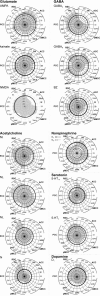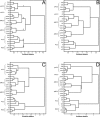Receptor architecture of human cingulate cortex: evaluation of the four-region neurobiological model
- PMID: 19034899
- PMCID: PMC6870973
- DOI: 10.1002/hbm.20667
Receptor architecture of human cingulate cortex: evaluation of the four-region neurobiological model
Abstract
The structural and functional organization of the human cingulate cortex is an ongoing focus; however, human imaging studies continue to use the century-old Brodmann concept of a two region cingulate cortex. Recently, a four-region neurobiological model was proposed based on structural, circuitry, and functional imaging observations. It encompasses the anterior cingulate, midcingulate, posterior cingulate, and retrosplenial cortices (ACC, MCC, PCC, and RSC, respectively). For the first time, this study performs multireceptor autoradiography of 15 neurotransmitter receptor ligands and multivariate statistics on human whole brain postmortem samples covering the entire cingulate cortex. We evaluated the validity of Brodmann's duality concept and of the four-region model using a hierarchical clustering analysis of receptor binding according to the degree of similarity of each area's receptor architecture. We could not find support for Brodmann's dual cingulate concept, because the anterior part of his area 24 has significantly higher AMPA, kainate, GABA(B), benzodiazepine, and M(3) but lower NMDA and GABA(A) binding site densities than the posterior part. The hierarchical clustering analysis distinguished ACC, MCC, PCC, and RSC as independent regions. The ACC has highest AMPA, kainate, alpha(2), 5-HT(1A), and D(1) but lowest GABA(A) densities. The MCC has lowest AMPA, kainate, alpha(2), and D(1) densities. Area 25 in ACC is similar in receptor-architecture to MCC, particularly the NMDA, GABA(A), GABA(B), and M(2) receptors. The PCC and RSC differ in the higher M(1) and alpha(1) but lower M(3) densities of PCC. Thus, multireceptor autoradiography supports the four-region neurobiological model of the cingulate cortex.
(c) 2008 Wiley-Liss, Inc.
Figures





References
-
- An X,Bandler R,Öngür D,Price JL ( 1998): Prefrontal cortical projections to longitudinal columns in the midbrain periaqueductal gray in macaque monkeys. J Comp Neurol 401: 544–479. - PubMed
-
- Botvinick MM,Cohen JD,Carter CS ( 2004): Conflict monitoring and anterior cingulate cortex: An update. Trends Cogn Sci 8: 539–546. - PubMed
-
- Bozkurt A,Zilles K,Schleicher A,Kamper L,Sanz Arigita E,Uylings HB,Kötter R ( 2005): Distributions of transmitter receptors in the macaque cingulate cortex. Neuroimage 25: 219–229. - PubMed
-
- Braak H ( 1976): A primitive gigantopyramidal field buried in the depth of the cingulate sulcus of the human brain. Brain Res 109: 219–233. - PubMed
-
- Broca P ( 1878): Anatomic comparée des circonvolutions cérébrales. Le grand lobe limbique et la scissure limbique dans la série des mammiféres. Rev Anthropol 1: 456–498.
Publication types
MeSH terms
Substances
Grants and funding
LinkOut - more resources
Full Text Sources

